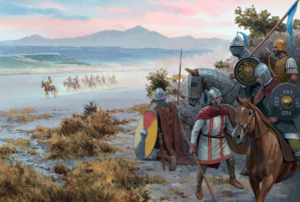Llyrian Commando Action
| Llyrian Commando Action | ||||||||||||
|---|---|---|---|---|---|---|---|---|---|---|---|---|
| ||||||||||||
The Llyrian Commando Action was a small scale brush fire war between The Commonwealth of Kaedrin and The Concord of Llyria between the years 1727 and 1730. Unable to engage in a full-scale military conflict due to Skydaemon interference, The Commonwealth of Kaedrin resorted to asymmetrical warfare and commando raids against The Concord of Llyria to achieve their goals. Ultimately the concerted effort of Kaedrin to neutralize Llyria would lead to its collapse several years later.
Prelude
Following the transition of The Republic of Ves Into the commonwealth of Kaedrin in 1726 at the hands of Adrian Helvets and Richard de Reden, Vesian citizens who preferred the easier way of life began to push back against the new militaristic and honour based state. Acts of vandalism, sabotage, civil unrest, and wide-scale destruction of Kaedreni property began to occur mainly aimed at the new government and the newly formed Army of Kaedrin, with several riots being forcefully crushed in the streets at the ends of batons and sometimes even blades, a period of temporary peace came to the city until 1727.
That year it was revealed that the subversives who had attempted to push back against the new Kaedreni society had moved their base of operations to The Concord of Llyria in southern Arcas, the group who sought to return Ves to its old ways continued their actions from the safety of Llyria, embarking on numerous anti Kaedreni propaganda campaigns aimed at the citizens of Kaedrin and continuing to stoke efforts of destruction and sabotage within the Red City of Ves. Adrian I and Richard de Reden reached out numerous times to the Llyrian government in the hopes of securing an extradition of the subversives but were rebuffed with the subversives already having been integrated into Llyria. Left with few options to secure the stability of The Commonwealth, the Army of Kaedrin formed from the battle-hardened Company of Caer Bann began to make preparations for war.
Actions on The Peninsula
Beginning in the summer of 1727, members of the Caernguard under the command of Arnold de Langford established a base of operations in several abandoned ships off the Llyrian coast. These elite soldiers and shock troopers quickly began seaborne raids against Llyria proper and the surrounding coastal villages, conducted for the purposes of information, Llyrian citizens were detained and exfiltrated from the nation for questioning after several of these detainments Captain Arnold de Langford had accurately attained a list of the Vesian subversives and their Llyrian addresses within the city.
With the rest of the Army of Kaedrin arriving in Southern Arcas in 1728, trade control operations and checkpoints began on the main road leading to Lyria, all lyrian merchants were detained with their goods seized and the merchants being shipped back to Ves to work in the gold mines of Mont Saint Catherine. With the borders of Llyria secure and under tentative Kaedreni control further operations against the city began, lacking a proper guard force or military, the ad hoc Llyrian militia originally put up no resistance to the Caernguard commandos. Entering the city in broad daylight the Caernguard began a door to door campaign with their prior retrieved addresses, rounding up several hundred Vesian subversives the Caernguard quickly retreated from the city with the detained prisoners returning the secured border where the prisoners were shipped back to the gold mines of Kaedrin to serve out their punishment.
Between 1728 and 1729 it is estimated that roughly 2000 Vesian subversives were extracted from Llyria to be returned to Kaedrin for punishment. As the campaign continued small skirmishes began to erupt as wealthy Llyrians sought to better equip their militia, with several bloody border clashes occurring near Kaedreni checkpoints with the Llyrians being routed each time, Richard de Reden deemed the mission largely complete and ordered the blockades lifted and marched the majority of the Army of Kaedrin back to Ves.
Despite the general withdrawal, the Caernguard under the command of Arnold de Langford was permitted by King Adrian to remain behind in their shipwreck base to continue operations and prevent Llyrian retaliation against Kaedrin, largely confined to hit and run raids against Llyria, the Caernguard began breaking into wealthy estates in order to remove material wealth from the Llyrians and limit their ability to equip their militia. The years of conflict however had begun to harden the Llyrian militia and most Caernguard raids began taking casualties for the first time in the war. In 1730 Governor-General Richard de Reden declared victory in the conflict and the Caernguard returned to Kaedrin their mission complete.
Aftermath
The armed intervention successful and with a large percentage of Vesian subversives either dead or sentenced to the gold mines in Ves, Kaedrin became rapidly more stable as a nation with their position in Arcas becoming properly entrenched with the Army of Kaedrin proving once more its ability to project power on the other side of the continent such qualities eventually transferring to the Imperial State Army several decades later.
The effects of the Llyrian Commando Action upon Llyria however, rapidly weakened its position within the realm. Despite attempts to continue to draw in more citizens and trade, The Concord of Llyria collapsed several years later after a drastic drop in population numbers with the few of its remaining citizens mostly moving to Sutica.
